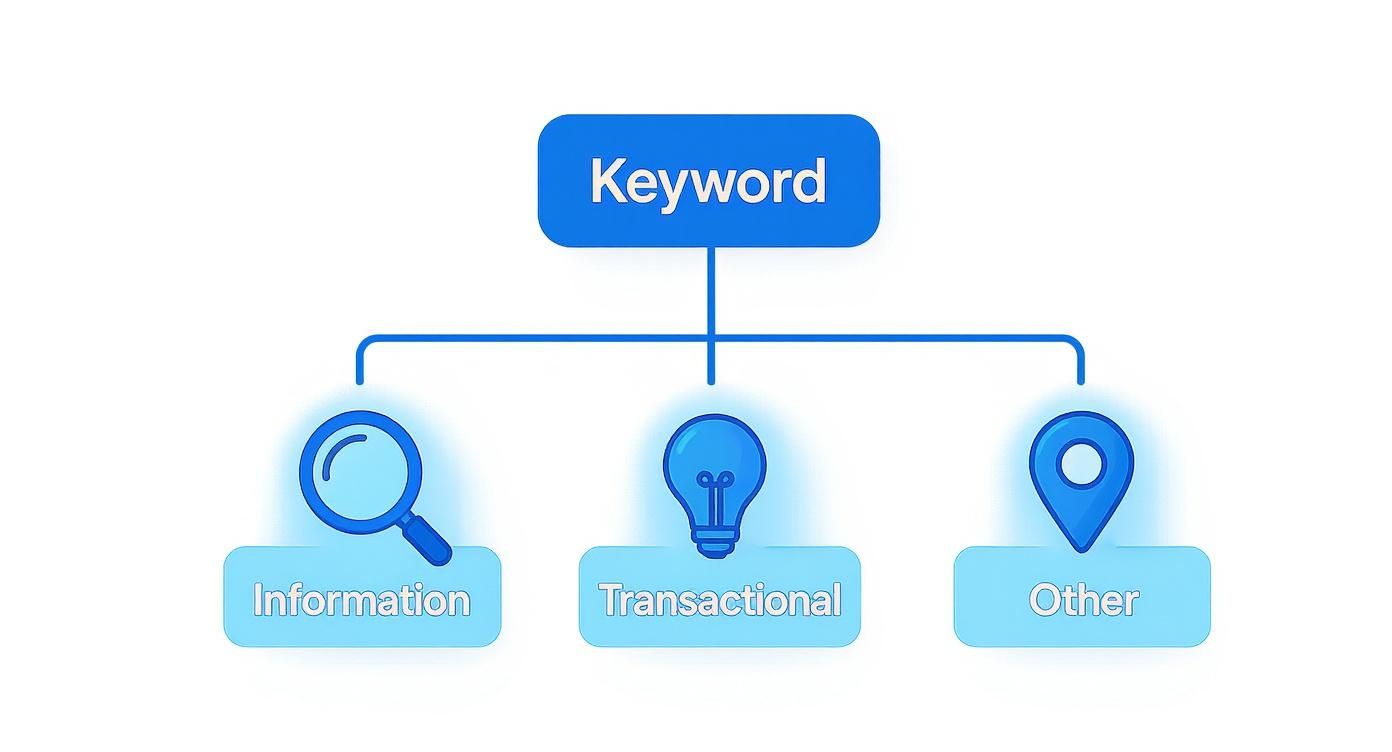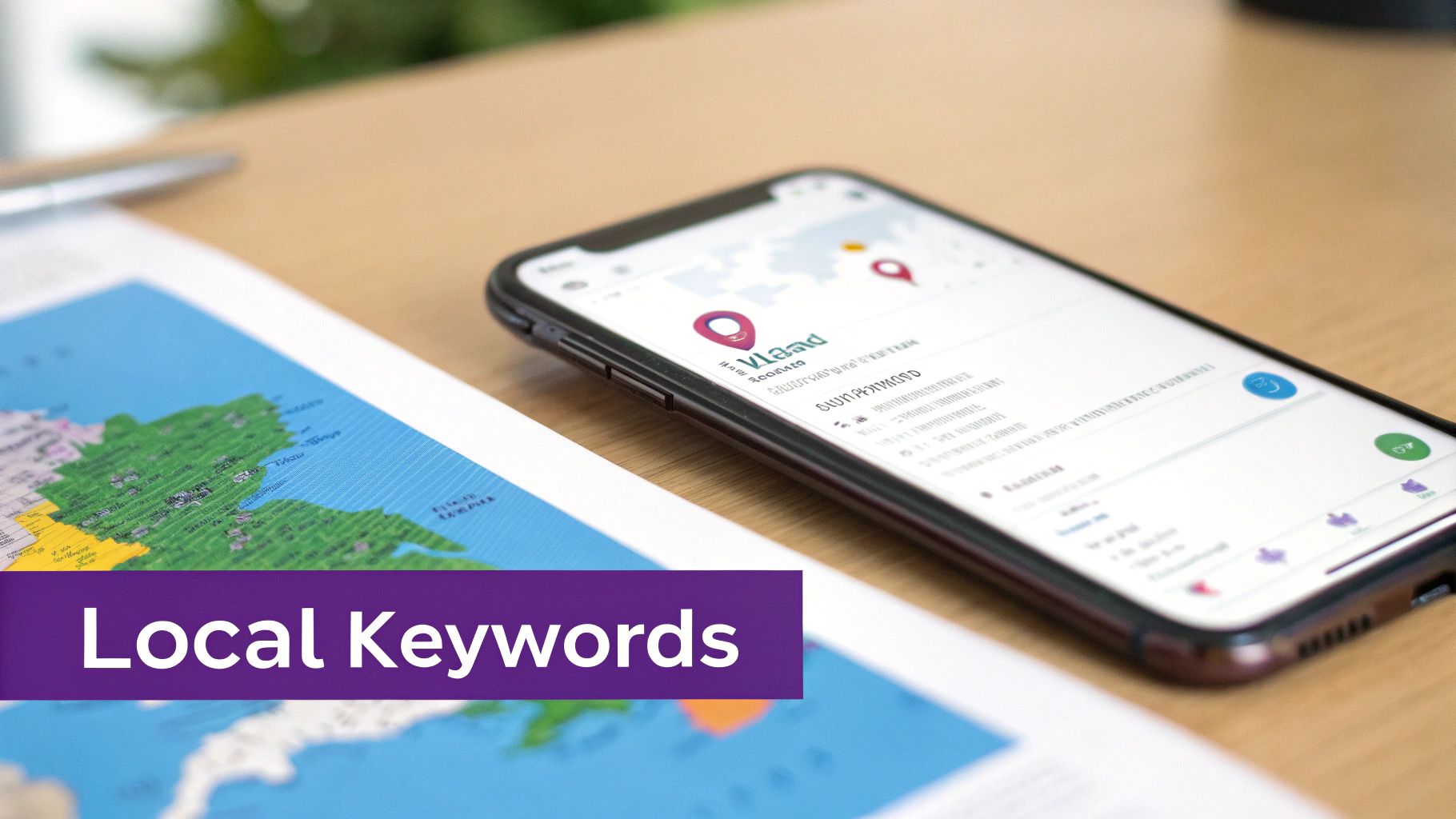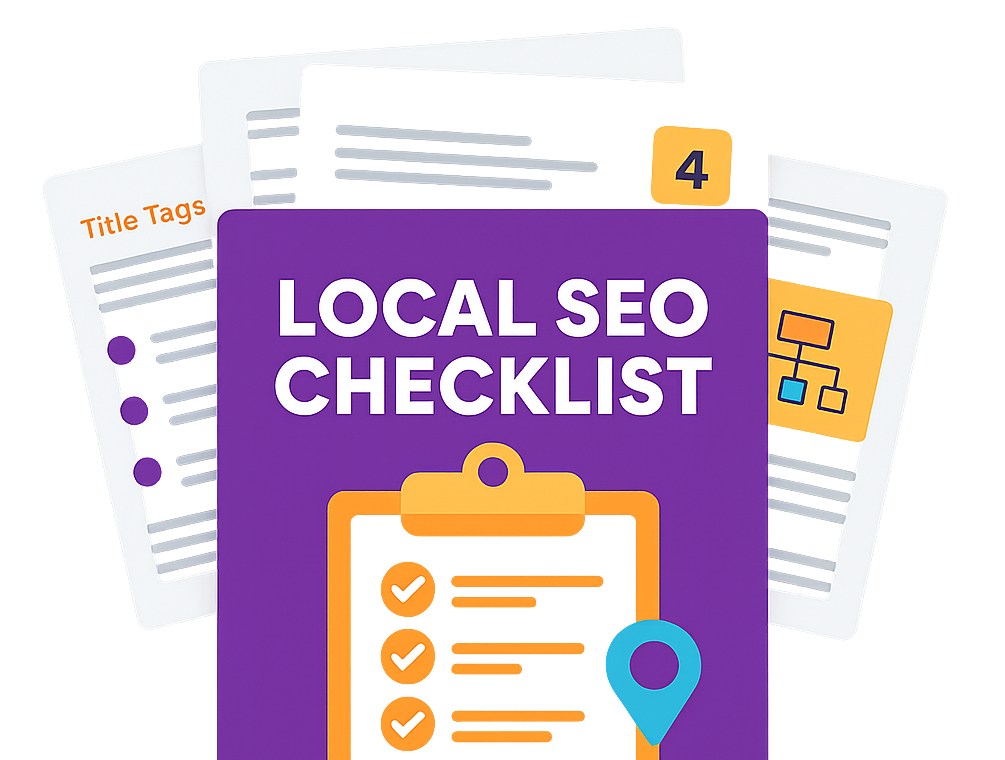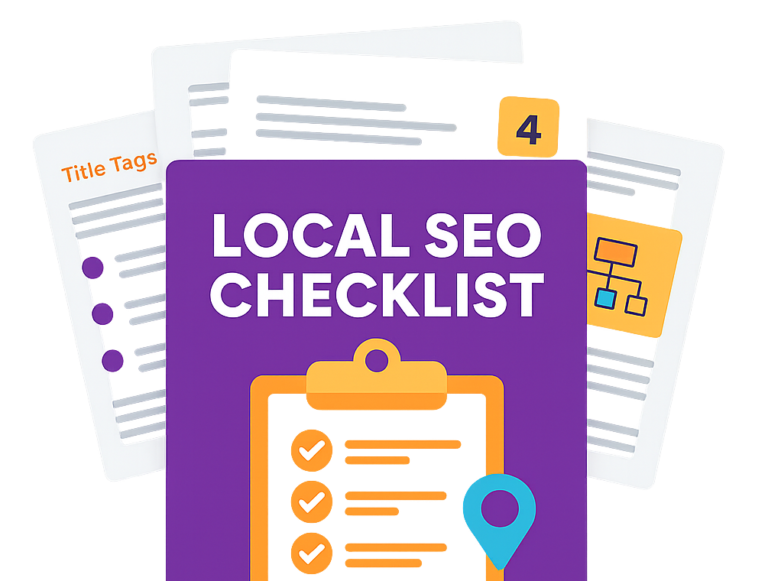Choosing the right SEO keywords isn't about guesswork; it's about getting inside your audience's head, understanding their problems, and aligning those needs with what your business actually does. This whole process is the bridge between what your customers are searching for and the content you create to help them.
Why Smart Keyword Research Is Non-Negotiable
Before you get lost in complex tools and massive spreadsheets, let's get one thing straight: choosing the right keywords is the absolute foundation of any decent search engine optimisation (SEO) strategy. It’s the critical link between what your potential customers are tapping into Google and the valuable solutions your business provides.
Get this part wrong, and even the most beautifully designed website with the sharpest copy will remain invisible. It’s as simple as that.
A thoughtful keyword strategy connects you with your audience at the exact moment they need you. It shifts your marketing from a 'spray and pray' approach to one that's informed by real data, ensuring every blog post, service page, or guide you create serves a clear and valuable purpose.
Aligning Keywords with Business Objectives
The very first step in understanding what is keyword research is to tie it directly back to your business goals. What are you actually trying to achieve? Are you looking to boost online sales for a specific product? Or maybe your goal is to build brand awareness right here in the Cambridgeshire area? Each objective demands a completely different type of keyword.
Here’s a quick look at how you can map your goals to the right kind of keywords.
Mapping Business Goals to Keyword Types
| Business Goal | Primary Keyword Type | Example Keyword (UK Focus) |
|---|---|---|
| Increase direct online sales | Transactional | "buy handmade leather journal UK" |
| Generate qualified leads | Commercial Investigation | "best accounting software for small business" |
| Build brand awareness | Navigational / Informational | "Bare Digital blog" or "how to start journaling for beginners" |
| Establish industry authority | Informational | "what is core web vitals" |
An ecommerce business gunning for sales should be all over transactional keywords that signal purchase intent, like "buy handmade leather journal UK." But if you’re a service-based business aiming to become the go-to expert in your field, you’ll want to target informational keywords, such as "how to start journaling for beginners."
A classic mistake I see all the time is businesses chasing keywords with huge search volumes without stopping to think if they're actually relevant. Sure, ranking for "journaling" might bring in a flood of traffic, but if those visitors have no intention of buying, that traffic is just a vanity metric. Real success comes from attracting the right audience, not just a big one.
Thinking Like Your Customer
Honestly, the most powerful SEO tool you have is your brain and your ability to empathise with your audience. You need to put yourself in their shoes. What words are they using when they’re frustrated with a problem you can solve? This is where you start brainstorming your initial 'seed' keywords.
These seed keywords are just broad, foundational terms that describe your main topics. If you run an artisan bakery in Cambridge, your seed keywords might be things like:
- Sourdough bread Cambridge
- Artisan cakes
- Local bakery delivery
- Wedding cake consultation
These aren't your final targets. Think of them as the starting point for a much deeper investigation into how real people search.
This customer-first approach is what turns a simple list of words into a genuine, revenue-driving asset for your business. For UK businesses, this is absolutely vital. Recent data shows that a massive 42% of people in the UK use search engines when looking for a product or service. That's more than double the number who use social media for the same reason. By meeting them with the right terms, you capture an audience that's actively looking for solutions. You can dig into more details about UK search behaviour in this SEO statistics report.
How to Find High-Potential Keywords
With your strategic groundwork sorted, it's time to roll up your sleeves and build a powerful list of keyword opportunities. This is where we move from theory to practice, using modern research tools to turn your initial brainstorm into hundreds of valuable search terms—the very backbone of your entire SEO campaign.

The goal here isn't just to find words. It’s to uncover what your UK customers are actually typing into Google. We're talking about the specific questions they’re asking and the problems they desperately need solving. It's about getting granular and moving from broad ideas to specific phrases that signal real intent.
Uncovering Customer Language With Keyword Tools
Your 'seed' keywords are just the starting point. Now, we'll use keyword research tools to expand them into a comprehensive list. Tools like Semrush, Ahrefs, or even free options like Google Keyword Planner are fantastic for this; they take your initial ideas and generate hundreds of related queries.
Let's say your seed keyword is "artisan bakery Cambridge." A good tool will immediately reveal what people are really looking for:
- "best sourdough bread Cambridge" (Clear commercial intent)
- "vegan birthday cakes Cambridge delivery" (High transactional intent)
- "how to make croissants from scratch" (Purely informational intent)
- "local bakeries near me open now" (Navigational and local intent)
These variations give you a direct window into your audience's mind and the language they use. You’ll quickly start to see patterns in their problems, which helps you group these terms into logical content themes.
Analysing Your Competitors' Winning Keywords
One of the smartest shortcuts in keyword research is to ethically peek at what’s already working for your competitors. Why reinvent the wheel when your rivals have done some of the heavy lifting for you?
Most SEO tools let you plug in a competitor's domain and see the exact keywords they rank for. This isn't about copying their strategy wholesale. It’s about spotting gaps and opportunities. You might find high-value keywords they’re stuck with on page two of Google, which could be an easy win for you with a superior piece of content.
Don't just look at their top-ranking keywords. Dig deeper into the terms that are driving the most traffic. Often, you'll find that a collection of less competitive, more specific phrases drives a significant portion of their organic visitors. This is your chance to swoop in.
This kind of analysis helps you benchmark your efforts and truly understand the competitive landscape. If a huge national chain is dominating the broad terms, you can smartly pivot to focus on the more specific, niche queries they've completely overlooked.
Expanding Your List With Question-Based Keywords
A massive chunk of Google searches are phrased as questions. People turn to search engines for answers, and by targeting these question-based keywords, you can position your content as the definitive solution they're looking for.
Tools like AnswerThePublic or the 'Questions' filter in the major SEO platforms are brilliant for this. They take your seed keyword and spin out a web of common questions people are asking around that topic.
For our bakery example, this approach might unearth gems like:
- How much does a custom wedding cake cost in the UK?
- Where can I find gluten-free bread in Cambridge?
- What is the difference between a macaron and a macaroon?
Each of these questions represents a potential blog post, guide, or FAQ page. They often fall into the category of long-tail keywords—longer, more specific phrases. These terms typically have lower search volume but much higher conversion rates because the user's intent is crystal clear. For a deeper dive, you can learn more about what long-tail keywords are and how they can be a complete game-changer for your strategy.
By systematically using these methods—expanding seed keywords, analysing competitors, and finding customer questions—you will quickly build a master list. This isn't just a jumble of words; it's a data-informed blueprint of your audience's mind, ready for the next stage of analysis and prioritisation.
Decoding the Intent Behind Every Search
A long list of keywords is just raw data. The real magic happens when you start to understand the ‘why’ behind each search. This is what we call searcher intent—figuring out exactly what someone hopes to find or do when they type a query into Google.
Nailing this is a massive ranking factor. It’s how you create content that doesn't just attract clicks but genuinely helps people. When your page matches what the user actually wants, you give them a better experience, and Google rewards you for it. Simple as that.
The Four Pillars of Search Intent
When you boil it down, every search query falls into one of four main categories. Getting your head around these helps you decide what kind of content to create to give yourself the best shot at ranking.
-
Informational Intent: The user wants to know something. They’ve got a question and they're looking for an answer, like "what is corporation tax?" or "how to repot a monstera". Their goal is pure learning.
-
Navigational Intent: The user is trying to get to a specific website. They already know where they're going and are just using Google as a quick way to get there. Think "Bare Digital login" or "BBC News".
-
Commercial Intent: The user is in research mode, getting ready to buy something. They're comparing products, looking for reviews, and weighing up their options. Keywords might look like "best CRM for small business UK" or "Samsung vs iPhone camera".
-
Transactional Intent: The user is ready to pull the trigger and take action right now. These searches often include words like "buy," "deal," or a specific product name, such as "buy airpods pro" or "emergency plumber Cambridge".
Understanding these differences is everything. For UK businesses, it’s particularly important. While 42% of UK users turn to search engines for products or services, a huge chunk of those searches start out as informational.
By creating content that answers these early-stage questions, you can get in front of potential customers long before they're ready to buy. A UK-based financial services firm, for example, could target "how to apply for a mortgage in the UK". This attracts people who aren't ready to commit yet but will be down the line, building trust and authority so they come back when they're ready for a transactional search.
How to Analyse the SERPs for Intent Clues
So, how do you figure out the intent for your keywords? Easy. Look at what Google is already ranking. The Search Engine Results Page (SERP) is a goldmine, showing you exactly what Google thinks users want to see for any given query.
Don't just guess what kind of content to create. Google the keyword yourself and analyse the top-ranking pages. The results will give you a clear blueprint for what works.
When you search for a target keyword, keep a close eye on a few things:
-
Types of Content: Are the top spots filled with blog posts, product pages, category pages, or videos? If the results for "best running shoes" are all e-commerce pages and review round-ups, your short blog post probably isn't going to cut it.
-
SERP Features: Is Google showing a Featured Snippet at the top? A "People Also Ask" box? An image pack or a local map pack? These aren't random; they're direct clues about what searchers are looking for—quick answers, visual guides, or local businesses.
-
Title and Description Language: Scan the page titles and meta descriptions. Are they full of words like "how to," "what is," "best," "review," "buy," or "price"? This language is a dead giveaway for the underlying intent.
By taking a few minutes to analyse the SERPs, you move from guesswork to a data-backed strategy. You’ll quickly get a feel for what kind of content will actually satisfy the user, making your pages far more effective. To really get to grips with this, have a look at our detailed article on what search intent is and the huge impact it has on SEO.
Right, you've done the hard graft and pulled together a massive list of keywords. The temptation is to dive straight in, but a long list is just raw potential. The real magic happens when you filter this spreadsheet chaos into an actionable plan. This is how you find the golden nuggets that will actually make a difference to your bottom line.
To do this properly, you need to look at each keyword through three critical lenses: search volume, keyword difficulty, and business relevance. It's all about finding that sweet spot where these three overlap, rather than just chasing big, flashy numbers.
Beyond Search Volume: The Full Picture
It's so easy to just sort your list by search volume and go after the biggest numbers. Honestly, it's a classic mistake. While search volume tells you how many people are looking for a term each month, it tells you nothing about the competition or whether that traffic is even right for your business.
High-volume terms are almost always fiercely competitive, dominated by huge national brands with marketing budgets to match. If you’re a small or medium-sized UK business, trying to rank for a term like "men's shoes" (with 22,000 monthly searches) is like trying to win a fistfight with a giant. It’s an uphill battle you're not likely to win.
Now, consider a more specific, long-tail keyword like "handmade leather brogues Northampton". It only gets 70 monthly searches, but that traffic is pure gold. These people know exactly what they want, and their search screams "I'm ready to buy". That’s the kind of traffic that converts.
Gauging Keyword Difficulty
Keyword Difficulty (KD) is a metric you'll find in most SEO tools that gives you a rough idea of how hard it will be to crack the first page of Google. It's usually scored from 0-100 and is calculated by looking at the authority of the pages already ranking.
Think of it like this:
- Low Difficulty (0-30): These are your low-hanging fruit. They're typically less competitive, which makes them perfect targets if your website is relatively new or you're looking for some quicker wins.
- Medium Difficulty (31-60): To rank for these, you'll need a really solid piece of content and you'll have to put some effort into promoting it, probably by building a few backlinks. They're definitely achievable, but they require a bit more muscle.
- High Difficulty (61+): These are the tough nuts. You'll be going up against highly authoritative websites, and getting to page one will demand a serious, long-term SEO commitment.
Your goal isn't just to find high-volume keywords; it's to find keywords with a healthy search volume relative to their difficulty. A term with 500 monthly searches and a KD of 15 is often a far better target than one with 5,000 searches and a KD of 75.
This visual shows how to think about categorising keywords based on what the user is actually trying to do—a crucial part of your analysis.

As the infographic shows, every keyword stems from a specific user need. Your job is to create content that perfectly matches whether they're looking for information, ready to buy, or somewhere in between.
Prioritising for Business Relevance
This is the final filter, and you could argue it's the most important one. A keyword might have amazing volume and low difficulty, but if it doesn't align with what you actually sell, the traffic is completely worthless.
You have to be ruthless and ask yourself:
- Does this keyword directly relate to a product or service I offer?
- Is the person searching this term a genuine potential customer?
- Can I, hand on heart, create the best piece of content on the internet for this topic?
If the answer to any of these is 'no', then that keyword probably isn't a priority, no matter how good the numbers look. A local plumber in Bristol, for example, gets zero value from ranking for "DIY plumbing tips London." The traffic is irrelevant.
The sweet spot for keyword selection lies at the intersection of reasonable search volume, achievable difficulty, and high business relevance. Overlooking any one of these three pillars will lead to a flawed strategy that wastes time and resources.
To bring this all together, you can create a simple scoring system in your spreadsheet. Give each keyword a score from 1-3 for each pillar—Volume, Difficulty, and Relevance. Add them up, and you’ll have a data-driven priority list staring right back at you.
A Simple Keyword Prioritisation Framework
To make this process more concrete, here's a simple framework. Use this table to score each keyword and decide where to focus your energy first.
| Evaluation Metric | Low Priority (Score 1) | Medium Priority (Score 2) | High Priority (Score 3) |
|---|---|---|---|
| Monthly Search Volume | Very low (e.g., <20) or impossibly high and broad | Moderate and achievable for your niche (e.g., 50-500) | High, yet specific enough to be relevant (e.g., 500+) |
| Keyword Difficulty | Very high (e.g., 60+) making it nearly impossible to rank | Moderate (e.g., 30-59), requiring a concerted effort | Low (e.g., <30), offering a realistic chance to rank quickly |
| Business Relevance | Loosely related to your offerings; attracts an irrelevant audience | Connects to your services but may not signal immediate purchase intent | Directly relates to a core product or service you provide |
By applying a structured analysis like this, your massive, overwhelming list transforms into a clear, strategic roadmap. You'll know exactly which keywords give you the best shot at attracting qualified traffic that actually converts, setting the perfect foundation for your entire content plan.
Winning with Local UK Keyword Strategies
For most UK businesses, whether you're running a café in Brighton or a solicitor's firm in Glasgow, attracting a local audience is everything. Generic SEO has its place, but real success often comes down to dominating your immediate geographical area. This is where you learn to pick SEO keywords that plug you straight into the community you serve.

It’s about shifting your focus to include location-based terms. Think less "emergency plumber" and more "emergency plumber in Manchester." The aim here is to capture high-intent customers right in your service area who are ready to make a purchase or booking.
Integrating Location into Your Keyword Research
The most direct way to do this is by combining your core service or product keywords with specific locations. And I don't just mean your primary city; you need to think hyper-locally. Consider the surrounding towns, specific districts, and even well-known landmarks that your customers might be typing into Google.
Start by jotting down a list of these location modifiers:
- Cities: "accountants in Birmingham"
- Boroughs or Districts: "artisan coffee near Shoreditch"
- Counties: "wedding photographer Cambridgeshire"
- Postcodes: "IT support SW19"
- Informal areas: "tapas restaurant Northern Quarter"
When you attach these to your main keywords, you’re targeting a much more qualified audience. It’s simple, really. Someone searching for "best artisan coffee near Shoreditch" is far more likely to walk through your door than someone just googling "best coffee."
Leveraging "Near Me" Searches
The explosion of mobile search has made "near me" queries a massive deal. While you can't directly target the phrase "near me" itself—Google figures that out based on the user's location—you can absolutely optimise your website to show up for these searches.
This all comes down to making sure your Google Business Profile is completely filled out, your address is consistent across every online directory, and you’re creating content that screams local relevance. For any business in the UK, getting a handle on these searches is a fundamental part of any effective local SEO strategies.
A key thing to remember is just how many searches have local intent. A staggering 46% of all Google searches are looking for local information. If you fail to optimise for your area, you're essentially ignoring nearly half of your potential online audience. Businesses that nail their location-based keywords drive high-quality, region-specific traffic that is far more likely to convert.
Spotting Local Trends and Opportunities
Beyond the obvious location keywords, modern tools can help you spot what's bubbling up in your local area. Google Trends, for example, is brilliant for this. You can filter search data by region to see what’s suddenly becoming popular near you.
You might discover a sudden spike in searches for "vegan bakeries in Bristol" or "outdoor seating pubs Leeds." This kind of data gives you a direct line into local demand, letting you create timely content that meets a specific, current need. It's a fantastic way to find keyword gaps your competitors have completely missed.
By combining broad service terms with specific location modifiers and keeping an ear to the ground for local search trends, you give yourself the tools to go beyond generic optimisation. This focused approach is how you dominate your local search results and build a real connection with your community.
Got Questions About Choosing Keywords?
Even with a solid plan, a few questions always seem to pop up during keyword research. It’s these little sticking points that can slow you down or make you second-guess your strategy. So, let's clear up some of the most common ones I hear from business owners and marketers.
Think of this as your go-to guide for turning keyword theory into confident, practical action.
How Many Keywords Should I Actually Target on One Page?
This is a classic, and the answer is all about focus, not cramming. For any given page, you should be laser-focused on one primary keyword. This is your north star—it defines the page’s core topic and guides every word you write.
But you don’t stop there. To really show search engines you know your stuff, you’ll want to back up that primary term with a small cluster of three to five closely related secondary keywords. These aren't just random phrases. They’re semantic variations, long-tail versions, or synonyms that add crucial context and depth.
For instance, if your primary keyword is "bespoke kitchen design London," your secondary terms might be things like "custom kitchen cabinets London," "luxury kitchen planner," and "made-to-measure kitchens in London." This tells Google your page is a comprehensive resource on that specific topic, not a thin piece of content trying to be all things to all people.
What’s the Real Difference Between Short-Tail and Long-Tail Keywords?
Getting your head around this is fundamental to choosing keywords that actually bring in business. It all comes down to specificity and, more importantly, intent.
-
Short-Tail Keywords: These are the big, broad, one-or-two-word searches, like "running shoes." They get a massive amount of monthly searches, but they’re also incredibly competitive. The real problem, though, is that the user's intent is a total mystery. Are they doing a school project? Looking for pictures? Thinking about buying? Who knows.
-
Long-Tail Keywords: Now we’re talking. These are super-specific, multi-word phrases, usually three words or more, like "best waterproof trail running shoes for wide feet." The search volume is much lower, sure, but the competition is a fraction of what it is for the big terms. And the best part? The intent is crystal clear. This person knows exactly what they want and is probably much closer to making a purchase.
While nabbing a top spot for a major short-tail keyword is a nice long-term dream, the immediate, tangible value for most businesses is found in the long tail. You attract higher-quality traffic that's far more likely to convert because you’re solving a very specific problem for a very specific person.
How Often Should I Revisit My Keyword Research?
Let’s be clear: keyword research is not a ‘set it and forget it’ job. The online world is always in motion—new trends emerge, customers change how they talk about their problems, and new competitors pop up. Your keyword strategy needs to be a living, breathing document to keep up.
As a general rule, I recommend a major review of your entire keyword strategy at least once a year. This is your chance to zoom out, re-evaluate your core topics, and make sure they still line up with your business goals.
But you need to be checking in far more often than that. A quarterly health check is essential to stay agile. It lets you spot new opportunities, identify keywords that are starting to fade, and tweak your content plan before you get left behind. If your business is seasonal, like a garden centre in Cambridgeshire, you’ll want to do these reviews even more frequently to match your business cycle.
Are Keywords Still a Thing with Google’s AI Getting So Smart?
Absolutely. But their role has definitely changed. There’s a common myth that as Google's AI gets better at understanding context, keywords don't matter anymore. The truth is the complete opposite—they’ve become the foundational signal for that context.
Google's AI is built to understand the intent and nuance behind a search, not to ignore keywords. Your job is to pick keywords that perfectly match that user intent and then build genuinely helpful, comprehensive content around them. The days of old-school tactics like ‘keyword stuffing’ are long gone.
Today, it's all about creating topic-focused content that naturally weaves in your primary keyword and its related terms. Smart keyword selection is the critical first step in showing both people and Google's AI that you're an authority on a subject. It tells them what your page is about, which is the only way you’ll ever rank for anything.
Ready to stop guessing and start ranking? Bare Digital offers specialist SEO services that turn data-driven keyword research into tangible results. Get your free, no-obligation SEO Health Check and a tailored Activity Plan to see exactly how we can boost your traffic and conversions.








